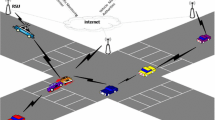Abstract
As an indispensable part of intelligent transportation system (ITS), inter-vehicle communication (IVC) emerges as an important research topic. The inter-vehicle communication works based on vehicular ad hoc networking (VANET), and provides communications among different vehicles. The wide applications of VANET helps to improve driving safety with the help of traffic information updates. To ensure that messages can be delivered effectively, the security in VANET becomes a critical issue. Conventional security systems rely heavily on centralized infrastructure to perform security operations such as key assignment and management, which may not suit well for VANET due to its high mobility and ad hoc links. Some works suggested that vehicles should be connected to fixed devices such as road side units (RSUs), but this requires deployment of a large number of costly RSUs in a specific area. This paper is focused on the issues on decentralized IVC without fixed infrastructure and proposes a method for Dynamic Establishment of Secure Communications in VANET (DESCV), which works in particular well for VANET communication key management when centralistic infrastructure or RSU is not available. We will demonstrate through synergy analysis and simulations that DESCV performs well in providing secure communications among vehicles traveling at a relative velocity as high as 240 km/h.







Similar content being viewed by others
References
Wischhof L, Ebner A, Rohling H (2005) Information dissemination in self-organizing intervehicle networks. IEEE Trans Intell Transp Syst 6:90–101, March
Zhang J, Zhang Q, Li B, Luo X, Zhu W (2006) Energy efficient routing in mobile ad-hoc networks: mobility assisted case. IEEE Trans Veh Technol 55(1):369–379, January
Kim KI, Kim SH (2005) A novel overlay multicast protocol in mobile ad hoc networks: design and evaluation. IEEE Trans Veh Technol 54(6):2094–2101, November
Lao L, Cui JH (2005) Reducing multicast traffic load for cellular networks using ad hoc networks. IEEE Trans Veh Technol 55(3):822–830, May
Mishra A, Nadkarni K, Patcha A (2004) Intrusion detection in wireless ad hoc networks. IEEE Wirel Commun 11(1):48–60, February
Huang YM, Yeh CH, Wang TI, Chao HC (2007) Constructing secure group communication over wireless ad hoc networks based on a virtual subnet model. IEEE Wirel Commun 14(5):70–75, October
Rivest R, Shamir A, Adleman L (1978) A method for obtaining digital signatures and public-key cryptosystems. Commun ACM 21(2):120–126, February
Merkle R, Hellman ME (1978) Hiding information and signatures in trapdoor knapsack. IEEE Trans Inf Theory 24(5):525–530, September
Shamir A (1984) A polynomial-time algorithm for breaking the basic Merkle–Hellman cryptosystem. IEEE Trans Inf Theory 30(5):699–704, September
Lagarias JC, Odlyzko AM (1983) Solving low-density subset sum problems. In: 24th annu. symp. foundations comput. sci, pp 1–10
Laih CS, Lee JY, Harn L, Su YK (1989) Linearly shift knapsack public-key cryptosystem. IEEE J Sel Areas Commun 7(4):534–539, May
Raya M, Aziz A, Hubaux JP (2006) Efficient secure aggregation in VANETs. In: International conference on mobile computing and networking, pp 67–75
Huang YM, Lin HY, Wang TI (2006) Inter-cluster routing authentication for ad hoc networks by a hierarchical key scheme. J Comput Sci Technol 21(6):997–1011, November
Zhu S, Setia S, Jajodia S, Ning P (2004) An interleaved hop-by-hop authentication scheme for filtering of injected false data in sensor networks. In: IEEE symposium on security and privacy, pp 259–271, May
Ye F, Luo H, Lu S, Zhang L (2004) Statistical en-route filtering of injected false data in sensor networks. In: Twenty-third annual joint conference of the IEEE computer and communications societies, pp 2446–2457, March
Perkins CE, Royer EM (2003) Ad-hoc on-demand distance vector routing. Internet Engineering Task Force, RFC 3561, July
Johnson D, Maltz DA, Hu YC (2007) The dynamic source routing protocol (DSR) for mobile ad hoc networks for IPv4. RFC 4728 IETF Mobile Ad Hoc Networks Working Group, February
Author information
Authors and Affiliations
Corresponding author
Rights and permissions
About this article
Cite this article
Yeh, CH., Huang, YM., Wang, TI. et al. DESCV—A Secure Wireless Communication Scheme for Vehicle ad hoc Networking. Mobile Netw Appl 14, 611–624 (2009). https://doi.org/10.1007/s11036-008-0138-1
Published:
Issue Date:
DOI: https://doi.org/10.1007/s11036-008-0138-1




